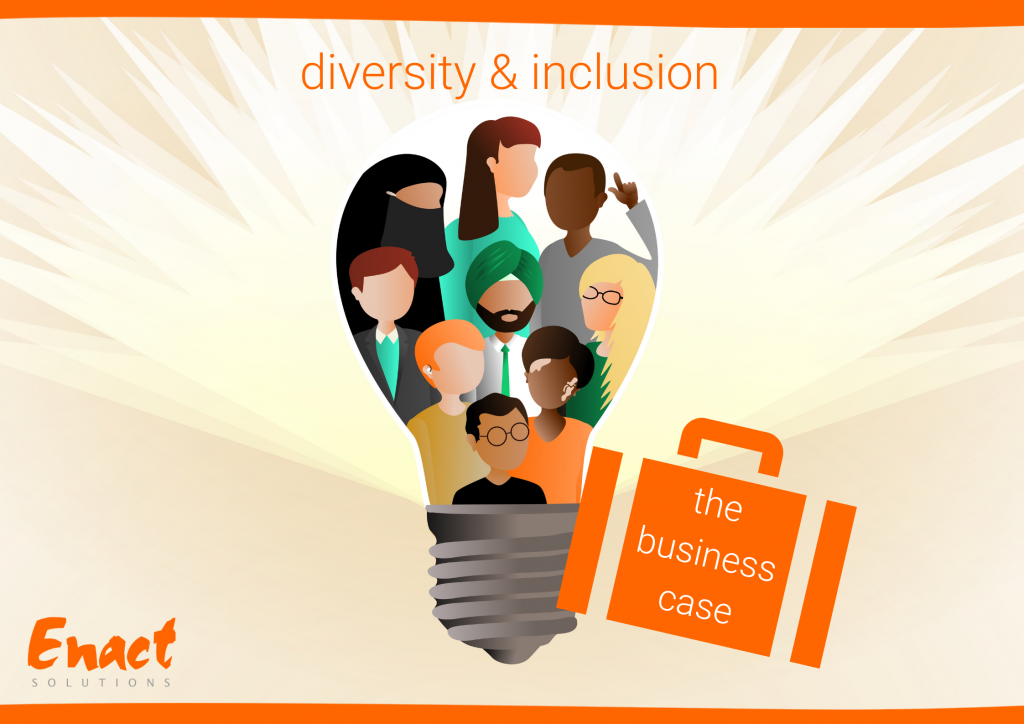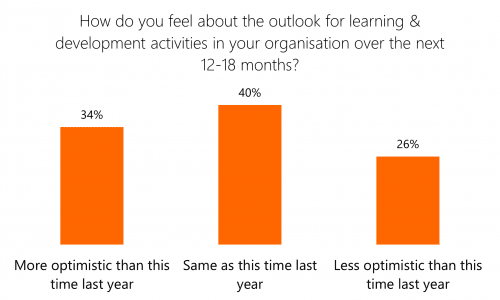- Is your workplace diverse?
- Representative of society?
- Both in its workforce and leadership?
- Do staff at your organisation feel valued and included?
If the answer to any of these questions is no, or you’re not sure, then this needs to become one of your company’s top priorities now. I mean it. Today!
. . . No matter how busy you are, there is no better time than now to focus on workplace diversity and inclusion. The subject has been studied in great detail. The science is robust and new studies are continually confirming and expanding on previous findings. The benefits are significant, vast and well documented and I can’t wait to share it with you.
If you’re unsure about any of the terminology, check out our handy whistle-stop tour of terms first!
What is the business case for workplace diversity & inclusion?
The business case for a diverse and included workforce is first and foremost about legality and the pursuit of social justice (a workforce free from discrimination, which is representative of society). However the benefits go much deeper. Workplace diversity and inclusion bring innovation, improved employee satisfaction, engagement, productivity, retention and future proofing, all of which are correlated with a range of increased and considerable financial benefits.
Research shows us that companies who don’t embrace diversity and inclusion as a matter of importance and commit to improving their practices in these areas, place themselves at a competitive disadvantage. Those who invest in diversity and inclusion early also reap increased rewards as time passes, with the opposite being true for those that don’t. As McKinsey & Company summarise: ‘It is better to invest now, since winners will pull further ahead and laggards will fall further behind.’
With that in mind, let’s explore each element of the business case in detail. To do this, I’ll be sharing data from a number of highly respected global studies, which date from 2007-2019 (full details at the bottom of this blog).
I’ve subtitled each benefit, written a short intro and bulleted the findings for ease of use. Take your time to read and reflect on each because the statistics are fascinating. They reveal the state of diversity and inclusion in companies today and the incredible gains those companies experience, when they commit to these values.
Equality Act 2010 and social justice
It is against UK law to discriminate against anyone because of age, disability, race (colour, nationality, ethnicity), sex, gender reassignment, sexual orientation, marriage/civil partnership, pregnancy/maternity leave, and religion/belief. It is important companies root out biases in recruitment, management, promotional practices etc to make sure people are not being discriminated against.
Whilst we strive for equality, unfortunately inequities still exist. Minority groups (women, racial and ethnic minorities, LGBTQ+ and people with disabilities etc) are most adversely affected and suffer from under-representation in the workforce and in leadership roles, disparity of pay, as well as report lower rates of inclusion.
Studies show:
- Women make up 12% of executive teams in the UK, despite being 50.9% of the population. -McKinsey & Co (4)
- More than a third of companies have no women on their executive teams. -McKinsey & Co (6)
- Only 22% of UK senior leadership teams accurately reflect the country’s racial diversity make-up. -McKinsey & Co (4)
- 78% of employees work at companies that lack 2-D diversity (see definition here) in leadership. -CTI (3)
- Ethnic and racial minorities and women are more likely to report that their careers have advanced slower than their counterparts. -McKinsey & Co (7)
Innovation
A diverse organisation holds within it the power for innovation. The mix of different perspectives, experiences and traits means companies are primed to explore ideas beyond the status quo and potentially tap into unmet or undiscovered markets. A diverse staff that has commonalities with its customer-base, is more likely to understand and innovate for that client, as well as adapt to changing needs.
Included teams are also more confident in sharing their insights because they know their leaders value their input. In contrast, under-valued employees may have good ideas, but fail to speak up, because their leaders don’t include or encourage their contribution.
Studies show diverse and included teams are more innovative than homogenous, undervalued teams. When faced with a problem, homogeneous groups display similar thinking and this shared line of thought and agreement with one another, results in an (over) confidence in the group’s surmises. They can fail to consider additional options, because their shared beliefs lead them to think they have solved the problem.
In comparison, because diverse and included groups bring a range of differences and experiences to the table, they are more likely to deploy different thinking, have dissimilar views, disagree with and debate one another. They challenge, rather than just accept assumptions, question the status quo and consider a wide range of options when problem-solving and innovating. They’re more thorough in their problem-solving approach and more likely to innovate a successful solution.
Whilst diverse and included team discussions may not be as enjoyable, easy or comfortable as those of a homogenous group (who converse more easily and quickly because of their shared thinking), the collaborative effort to problem-solve utilising a wide range of perspectives ultimately yields better results.
Studies show:
- Leaders with 2D diversity are more inclusive and innovative as a company than those who aren’t. -CTI (3)
- Companies with 2D Diversity are 70% more likely to report new markets. -CTI (3)
- Employees are 72% more likely to report that their team is not afraid to challenge the status quo, when their leaders have 2D diversity, compared to leaderships with no inclusive behaviours. -CTI (3)
- Leaders with 2D diversity are 117% more likely to make sure all team members speak up and are heard (as reported by their employees), than leaders with no inclusive behaviours. This range of ideas, opinions and solutions can lead to market-value innovations. -CTI (3)
- Teams with one or more employees who share a client’s characteristics (ethnicity, gender, culture or sexual orientation) are as much as 158% likelier to understand that client, and so more likely to successfully innovate for that client. -CTI (3)
- Ideas from LGBTs, women, racial minorities and Generation Y (that could have market potential) are less likely to secure the backing they need, as 56% of leaders don’t value ideas they don’t see a need for. -CTI (3)
Financial
Multiple studies highlight the financial benefits diversity and inclusion in the workplace are correlated with (especially in senior leadership teams). These include increased profitability, increased market share and the ability to tap into new markets through previously undiscovered / unmet customer needs.
Why is this? McKinsey & Co (4 and 5) hypothesise that diverse companies with a reputation for inclusion are better able to attract ‘top talent’. Given the human benefits diversity and inclusion bring, it makes sense that highly intelligent and skilled workers would want to work for these types of companies. This in turns means the companies are more innovative, produce higher quality work, maximise markets etc, all of which contributes to greater financial returns.
Studies show:
- Companies with more diverse workforces perform better financially. -McKinsey & Co (4)
- Companies with 2D Diversity are 45% more likely to report increased market share. -CTI (3)
- Companies with high employee engagement had a 19% increase in operating income and almost a 28% growth in earnings per share. -TP (1)
- Companies with low employee engagement had a 32% decrease in operating income and earnings per share decline over 11%. -TP (1)
- Companies in the top quartile for ethnic diversity on executive teams were 36% more likely than companies in the fourth quartile to have above-average profitability in 2019. In 2017 it was 33% and in 2014 it was 35%. -McKinsey & Co (6)
- Companies in the top quartile for gender diversity on executive teams were 25% more likely than companies in the fourth quartile to have above-average profitability in 2019; up from 21% in 2017 and 15% in 2014. -McKinsey & Co (6)
- Companies in the fourth quartile for both gender and ethnic diversity on executive teams were 27% more likely to underperform on profitability than all other companies. -McKinsey & Co (6)
Employee Satisfaction
Workplace diversity and inclusion, or lack of, contributes to employee satisfaction or dissatisfaction. When someone is not included at work, be it in general office chit-chat, team meetings, projects or social events etc, it affects their level of satisfaction within their role, team and the organisation. This level of satisfaction can impact on employee engagement, productivity and retention, all of which has financial implications for a company.
McKinsey & Co studied inclusion in terms of microaggressions in the workplace in 2019. Minority groups (LGBTQ+, women, ethnic / racial minorities) reported experiencing more microaggressions than other respondents. For example:
- 39% of LGBTQ+, 34% of women, and 29% of ethnic or racial minorities reported hearing derogatory comments / jokes about people like them (versus 21% of men). -McKinsey & Co (7)
- 30% of women, 26% of ethnic or racial minorities, and 23% of LGBTQ+ reported being excluded from social events (versus 12% of men). -McKinsey & Co (7)
- 61% of LGBTQ+, 39% of women, and 33% of ethnic or racial minorities reported needing to correct others’ assumptions about their personal lives (versus 22% of men). -McKinsey & Co (7)
Diversity and inclusion within senior leadership also plays a role on employee satisfaction. For example:
- Leaders with 2D diversity are more than twice as likely to ensure team members speak up and are heard, empower team members to make decisions and share credit for team success (as reported by their employees), than leaders without 2D diversity; all of which feeds into staff satisfaction. -CTI (3)
Engagement and productivity
Edward Hubbard found that diverse teams properly managed and trained produce 6 times higher results than homogenous teams. When employees feel valued and included, this leads to higher levels of engagement (both individually and in teams) and in turn leads to greater productivity.
Studies show:
- A sense of inclusion is strongly linked with employee engagement. -McKinsey & Co (7)
- 38% of employees are ‘disenchanted’ or ‘disengaged’. -TP (1)
- Senior management sincerely interested in employee wellbeing is the top driver of engagement globally. -TP (1).
- ‘Individual discretionary effort’ improves by 12% in a more diverse and inclusive workforce. -CEB CLC (2)
- Team collaboration and commitment improves by about 50% in a more diverse and inclusive workforce. -CEB CLC (2)
Retention and future proofing
In the competitive world businesses operate in, employers must do all they can to attract and retain top talent. The leaders of tomorrow are increasingly growing up in a global world. They’re taught about diversity and inclusion from an early age and want to work at companies which share these same values.
High fliers also want to work for forward-thinking, dynamic companies and with diversity being a key driver of innovation, employers who fail to make this a priority, do so at their peril. Top talent take diversity and inclusion into account when deciding where they want to work and whether or not they want to remain.
Employee turnover is costly, from advertising roles, interviewing and recruiting candidates, to inducting and training new employees. The more a company can do to make their workplace attractive through celebrating diversity, valuing their staff and all their differences, the more likely it is employees will want to stay.
Studies show:
- Employees who feel very included at work are nearly 3 times more likely than their peers to feel excited by and committed to their organisations. -McKinsey & Co (7)
- Intent to stay improves by 20% in more diverse and inclusive workforces. -CEB CLC (2)
- When making career decisions, employees from all demographics have considered their organisations’ inclusiveness and would like their organisations to do more to improve inclusion and diversity. -McKinsey & Co (7)
- 35% of employees say their organisations put too little effort into creating a diverse, inclusive environment. -McKinsey & Co (7)
- 39% of employees turned down or didn’t pursue a job because of a perceived lack of company inclusion. -McKinsey & Co (7)
Some final thoughts
The business case for workplace diversity and inclusion is strong. The only question that remains now is: What are you going to do about it?
Whilst company policies may profess a commitment to diversity and inclusion, in order to receive the incredible benefits as evidenced above, these must be put into practice. Employees need training, understanding and action on diversity and inclusion, on a regular and ongoing basis.
Here at Enact Solutions we run equality, diversity and inclusion training which is creative, interactive, with business-relevant content. To find out more about it and the results we yield, check out our website, by clicking on the link above. We can’t wait to work with you!
Research studies
-
Source: Towers Perrin, Global Workforce Study (Report written 2008, data from 2007-2008. Data set close to 90,000 workers covering 18 countries.)
-
Source: CEB Corporate Leadership Council, (now Gartner), Create Competitive Advantage Through Inclusion (White paper written 2012)
-
Source: Center for Talent Innovation, (now Coqual), Innovation, Diversity and Market Growth, ‘How Diversity can drive innovation’. (Written 2013. Data set of 1,800 professionals, 40 case studies.)
-
Source: McKinsey & Company, Why diversity matters (Report written Jan 2015, data from studies 2010-2013. Data set of 366 public companies across a range of industries in Canada, Latin America, the UK and US.)
-
Source: McKinsey & Company, Delivering through diversity (Report written Jan 2018, data from 2017. Data set of more than 1,000 companies covering 12 countries.)
-
Source: McKinsey & Company, Diversity wins: How inclusion matters (Report written May 2020, data tracked from 2014-2019) Data set of more than 1,000 large companies, across 15 countries.)
-
Source: McKinsey & Company, Understanding organisational barriers to a more inclusive workplace (Report written June 2020, data from September 2019. Data set of 1,920 participants representing the full range of regions, industries, company sizes, functional specialties, and tenures. The survey was also sent to McKinsey’s networks of LGBTQ+ senior leaders and garnered an additional 110 responses among those groups.)
Jemma Houghton
Jemma Houghton is one of our Associates at Enact Solutions. She’s passionate about people feeling respected, valued and working together to create positive results. For additional reading on this topic, check out our recent blog: ‘Diversity, inclusion, equality and equity: a whistle-stop tour of terms‘.




